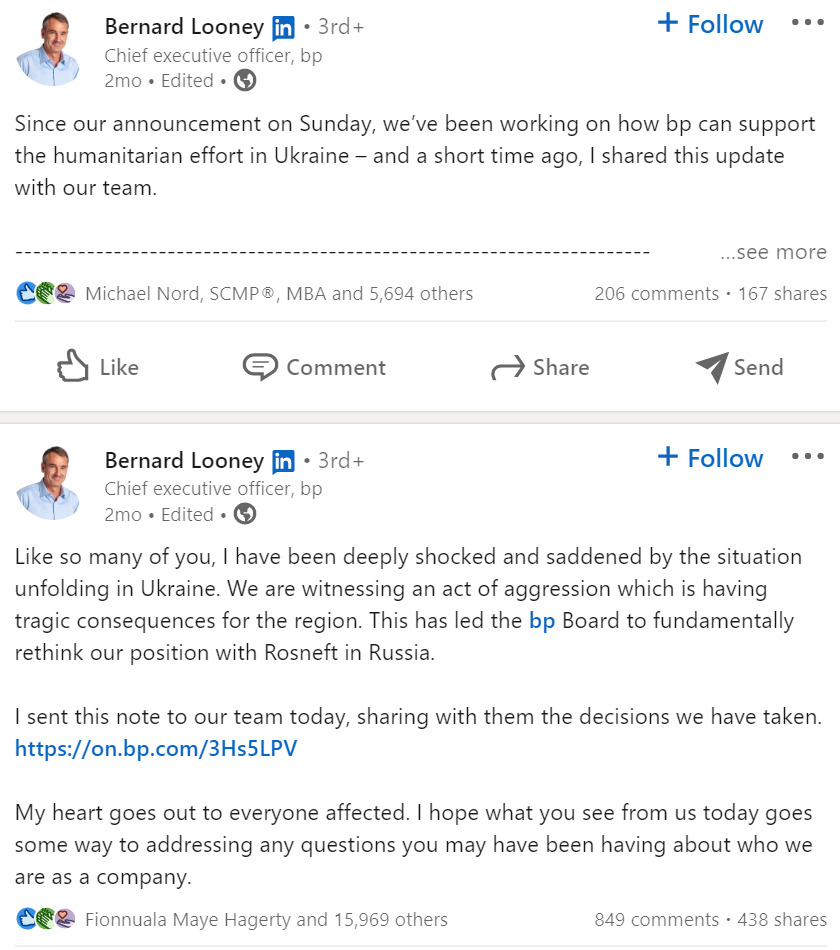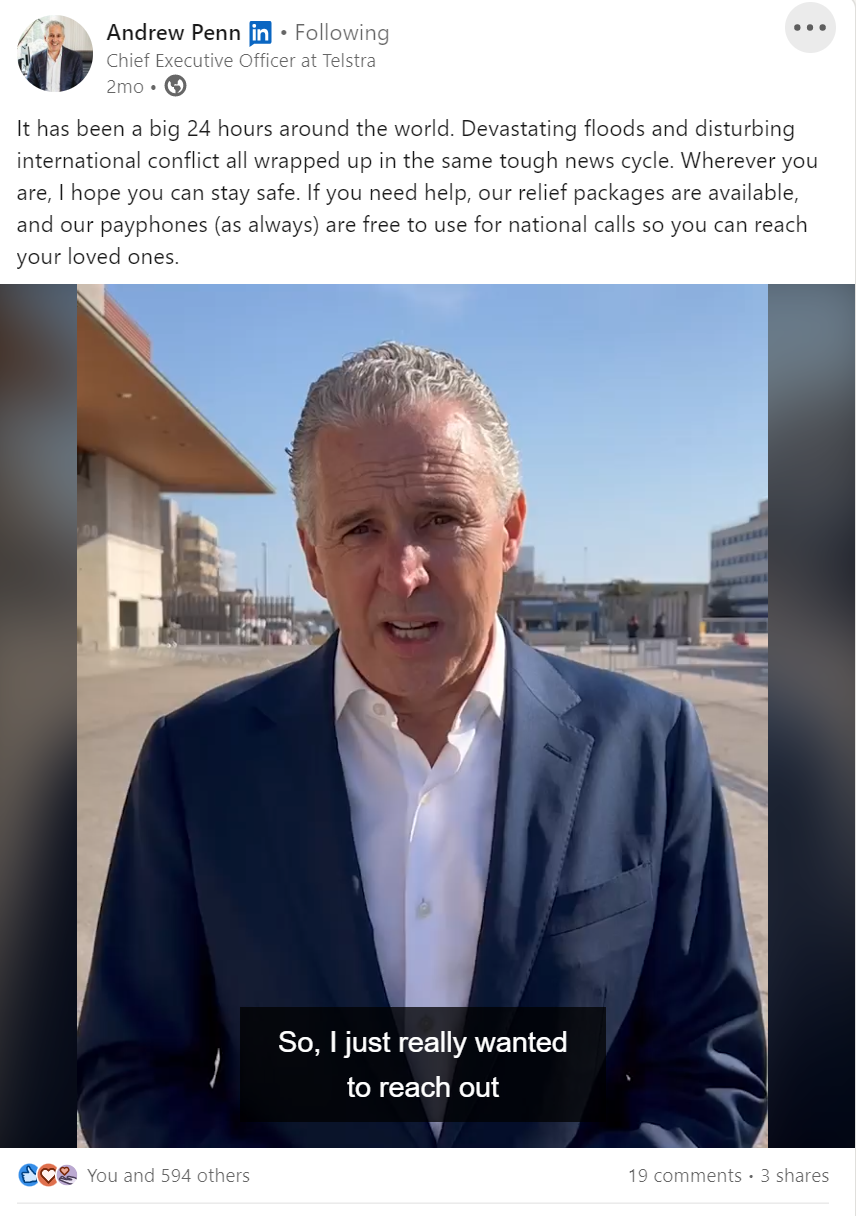Leadership in crisis: should they speak up on global issues like the Ukraine invasion and movements such as Black Lives Matter?
Join Propel’s Roger Christie, and co-founder of Brightside Digital Engagement, Phil Szomszer as they discuss how leaders can respond to major events and crises in a way that protects and even enhances their digital reputation.
In the episode we explore:
– how 50 CEOs approached social media during the Ukraine invasion;
– examples of leaders like BP’s Bernard Looney, Telstra’s Andy Penn and McDonald’s Chris Kempczinski using their digital presence in crisis;
– how leaders and communications teams can respond to a demanding social media audience in times of crisis;
– the impact of silence online from a leader, and
– the importance of pre-planning to enable leaders to make an impact online when it matters most.

The insights + advice.
Roger Christie: “How should leaders use their digital presence during major events or crisis?”
Phil Szomszer: “The war in Ukraine is highly unusual. We’ve never seen anything of its kind before as comms professionals. It’s been a real test of CEOs and business leaders approach to using social media: Should we, shouldn’t we post, should we stop posting?
“So we did some desk research of 50 CEOs of listed companies, mostly in the UK and the US.
“We looked at those leaders who were already active on LinkedIn and what we found was most business leaders carried on posting once the war had started.
“In fact, 84% of CEOs carried on posting. 42% of them posted explicitly about the invasion, and 36% posted about action oriented posts. (And what I mean by that is saying what they’re actually doing about it, whether it’s withdrawing from Russia or sending aid or doing something along those lines).”
Roger Christie: “How might you counsel a leader, or communications team, who is fearful of responding to these sorts of things in the future?”
Phil Szomszer: “CEO’s are really nervous about social media. I hear things like, “Oh, it’s too risky. I can’t deal with the volume of responses. I’m worried about what happens if it spirals out of control? I can’t control all the messages.
“Really, I think a lot of what we do is actually more in the PR world than marketing. You should prepare for social media in the same way that you would to media relations. You practice, you set things up properly, you have a team behind you, you work out your messaging.
“It’s exactly the same as what we’ve all been trained to do, those of us that have come through the PR channel. So, I would advise them to think of it in those terms. The big advantage of social media is that you are in control of the channel.”
Roger Christie: “What does silence look like in times like these, when stakeholders are looking for guidance?”
Phil Szomszer: “I’m not a fan of it. I think if you’re already silent, then people will just take to other channels. By remaining silent during times of hardship, you’re not having an opportunity to have your say. You’re missing out on your right of response, to steer the narrative in the direction you want to steer it.
“For those that are suddenly silent, I think that’s a different thing because that suggests some sort of guilt or some sort of avoidance of the situation.
“I don’t know if you’ve seen the piece of research that Yale School of Management has done? It’s kind of a naming and shaming, but it’s basically looking at the number of companies that are still active in Russia. There’s 500 companies to date who have pulled out of Russia. It’s showing the companies that have completely withdrawn those that are sort of hedging their bets and those that are, not withdrawing at all.”
Roger Christie: “We always talk to clients about not building your fort in the battle. During a crisis is the worst time to go up and stick your head up – the best time to get attention and awareness – but certainly not the best time to protect your reputation. So I wouldn’t encourage it. But what do you advise people who suddenly see this as an opportunity to start? What benefit does this pre-planning provide?”
Phil Szomszer: “I think the advantage of pre-planning is really around getting your story straight and working out what your online persona is going to be.
I think one of the differences that you see from a regular social media planning and strategy is that you can’t just take the brand channels messaging and say right if we’re BP for example, let’s look at the message house and then just apply that to CEO, Bernard Looney. Because Bernard Looney is a human being, he needs to get his own authentic self to come across.
So, when you’re going through that planning process, it’s not just taking the narrative and the messaging documents from corporate comms and saying right now let’s apply it and overlay it onto humans.”
Digital leadership in practice.
BP’s CEO Bernard Looney is one leader who did something few other CEOs did following the invasion of Ukraine. He responded to the situation with some very empathetic posts explaining the action he was taking. He was able to reply in a very balanced and robust way to comments about his lack of response to other situations.
McDonalds CEO, Chris Kempczinski is another great example digital leadership crisis. He wrote a great post detailing McDonald’s financial support for their team in Ukraine, and explaining the very real and human complexities to withdrawing from the Russian market.
And in our own backyard, CEO of Australia’s largest telecommunications business Telstra, Andy Penn, shared a heartfelt video from a conference in Barcelona raising awareness about the invasion in Ukraine and the devastating floods that were impacting Australians along the east coast of our country. This simple gesture simultaneously acknowledged the conflict and devastation taking place globally, and the impact that would have on the audiences listening to his commentary on LinkedIn.
Phil’s final takeaway.
Phil Szomszer: “Don’t start with your CEO. Make sure you’ve got some learnings to draw from.
“Spend some time getting your story right. Get their buy-in. It’s essential they realise that having a digital presence is part of their job in the same way that they take to doing a media interview. They’ve got to take it seriously and take some ownership of it. They have to be involved and see the advantages to them personally as well, that this is a good thing for them.
“And think about this being part of a long-term strategy. You can’t just expect to get sort of instant results and everything to work perfectly on day one. Reputation isn’t built overnight.”
To listen to this conversation in full, head to Apple Podcasts, Spotify or wherever you get your podcasts.
Once there, please subscribe, leave a review or drop us a note with any thoughts from this conversation – we’d love to hear from you.

